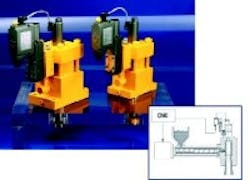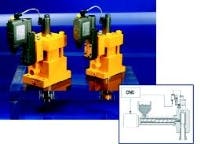Electrohydraulics in Parison control
Parison control is used in plastic blow-molding machines to achieve optimum and uniform wall thickness of continuously extruded profiles. This can be accomplished with zero-lapped, high response proportional valves.
Parison control is a well-known process in plastic blow-molding machines to achieve the optimum and uniform wall thickness of continuously extruded profiles. It is used to obtain hollow items, as plastic bottles, tanks etc., whose thickness can be modulated depending to the required localized mechanical resistances.
Wall thickness regulation can be attained by means of standard digital-servoactuators composed of:
- a custom-designed servocylinder equipped with low-friction seals and an integral position transducer
- a high response proportional valve with zero-lapped spool and LVDT position transducer;
- digital integral electronics with double closed-loop control of pilot valve regulation and cylinder rod position. An RS232 serial communication interface allows tuning electronic control parameters via software to optimize the Parison performance.
This material was submitted by Fabio Balzarini, of Atos spa, Milan Italy. For more information, visit www.atos.com.


